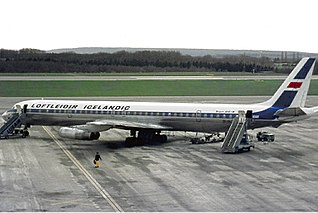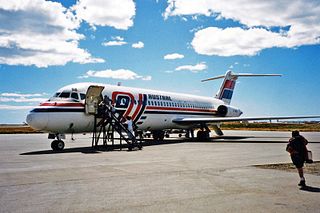
Loftleiðir Icelandic Airlines Flight 001, was a flight chartered by a Douglas DC-8. The aircraft crashed on 15 November 1978, on approach to the international airport in Colombo, Sri Lanka. The crash killed 8 of the 13 Icelandic crew members, 5 reserve crew members, and 170 Muslim pilgrims from South Borneo out of a total of 262 passengers and crew. The official report by Sri Lankan authorities determined the probable cause of the crash to be failure of the crew to conform to approach procedures; however, American and Icelandic authorities claimed faulty equipment at the airport and air traffic control error as the reasons for the crash.

Air Algérie Flight 702P, named Oasis and registered 7T-VEE, was a Boeing 737 owned by Air Algérie and leased by Phoenix Aviation. On 21 December 1994, in low visibility conditions, it collided with power transmission cables and a pylon during its final approach to Coventry Airport in the United Kingdom. The aircraft subsequently overturned and damaged several houses before crashing inverted into a wooded area beyond. All five people on board were killed.

Austral Líneas Aéreas Flight 2553 was an Argentinian domestic scheduled passenger flight from Posadas to Buenos Aires. On October 10, 1997, the McDonnell Douglas DC-9-32 that was operating the flight crashed on the lands of Estancia Magallanes, Nuevo Berlín, 32 kilometres away from Fray Bentos, Uruguay. All 74 passengers and crew died upon impact. The accident remains the deadliest in Uruguayan history.

Indian Airlines Flight 605 was a scheduled domestic passenger flight from Bombay to Bangalore. On 14 February 1990, an Airbus A320-231 registered as VT-EPN, crashed onto a golf course while attempting to land at Bangalore, killing 92 of 146 people on board.

China Southern Airlines Flight 3456 (CZ3456/CSN3456) was a scheduled domestic passenger flight from Chongqing Jiangbei International Airport to Shenzhen Huangtian Airport. On 8 May 1997, the Boeing 737 performing this route crashed during the second attempt to land in a thunderstorm. The flight number 3456 is still used by China Southern and for the Chongqing-Shenzhen route but now with the Airbus A320 family or Boeing 737 Next Generation aircraft.

Polica, locally known as Police, is a mountain, 1,369 m (4,491 ft), in southern Poland near Zawoja, in the Żywiec Beskids mountain range.

Turkish Airlines Flight 634 was a scheduled domestic passenger flight from Istanbul Atatürk Airport to Diyarbakır Airport in southeastern Turkey. On 8 January 2003 at 20:19 EET, the aircraft operating the flight, a British Aerospace Avro RJ100, struck the ground on final approach approximately 900 metres (3,000 ft) short of the runway threshold during inclement weather conditions. In the following collision with a slope, a post-crash fire broke out, killing 75 of the 80 occupants, including the entire crew. This is the deadliest aviation accident to involve the BAe 146.

Iberia Flight 610 was a scheduled domestic passenger flight from Madrid to Bilbao, Spain. On 19 February 1985, a Boeing 727-200 operating the flight crashed into a ravine after one of its wings sliced a television antenna on the summit of Mount Oiz in Biscay during an approach to Bilbao Airport. All 141 passengers and 7 crew on board died. The crash is the deadliest aviation disaster in both the Basque Country and Iberia history.

Aviateca Flight 901 was a scheduled international passenger flight which crashed into the 7,159-foot (2,182 m) San Vicente volcano in El Salvador on approach to the Comalapa International Airport on 9 August 1995. The accident killed all 65 passengers and crew on board and is the deadliest aviation disaster to occur in El Salvador. An investigation by the Civil Aviation Authority determined that pilot error and air traffic control error in bad weather contributed to the accident.
Dan-Air Flight 1903 was an unscheduled international passenger service from Manchester to Barcelona, operated by Dan Air Services Limited under contract with British tour operator Clarksons Holidays, which arranged for the flight to carry a group of holidaymakers who had booked an all-inclusive package holiday with the operator.

Aeroflot Flight 141 was an international flight from Moscow to Prague. On 19 February 1973, the Tupolev Tu-154 crashed 1.5 kilometres short of runway 25 of Prague Ruzyně Airport. Most of the passengers survived the crash, but many died in the fire that followed. Out of the 87 passengers and 13 crew members, 62 passengers and 4 crew members perished with 18 occupants having serious injuries and the remaining 16 with either minor or no injuries. The crash was the first loss of and first fatal accident involving the Tu-154.

Aeroflot Flight 217 was a non-scheduled international passenger flight from Orly Airport in Paris to Sheremetyevo International Airport in Moscow, with a stopover at Shosseynaya Airport in Leningrad. On 13 October 1972, the Ilyushin Il-62 airliner operating the flight crashed on approach to Sheremetyevo, with the loss of all 164 passengers and crew of 10. At the time, it was the world's deadliest civil aviation disaster, until it was surpassed by the Kano air disaster in 1973. As of 2023, this remains the second-deadliest accident involving an Il-62, after LOT Flight 5055, and the second-deadliest on Russian soil, after Aeroflot Flight 3352.

Aeroflot Flight 3932 was a flight operated by Aeroflot from Koltsovo Airport to Omsk Tsentralny Airport. On 30 September 1973, the Tupolev Tu-104 operating the route crashed shortly after takeoff from Sverdlovsk, killing all 108 passengers and crew on board.

The 1951 LOT Li-2 Tuszyn air disaster occurred on 15 November 1951 when a LOT Polish Airlines Lisunov Li-2 flew into power lines near Tuszyn, crashed and burst into flames. All 15 passengers and 3 crew died. It was the first LOT aircraft disaster since the end of World War II.

Aeroflot Flight 721 was a scheduled domestic passenger flight between Moscow and Yuzhno-Sakhalinsk in the Russian SFSR. On Wednesday, 2 September 1964, the aircraft flying this route, an Ilyushin Il-18V, crashed into the side of a hill on approach to Yuzhno-Sakhalinsk, killing 87 of the 93 people on board. At the time of the accident, it was the deadliest Il-18 crash and the deadliest aviation accident on Russian soil.

Aeroflot Flight 109 was a scheduled domestic passenger flight from Moscow to Chita with stopovers in Chelyabinsk, Novosibirsk, and Irkutsk. On the final leg of the route on 18 May 1973 a terrorist hijacked the aircraft, demanding to be flown to China; the terrorist's bomb detonated in flight after he was shot by the air marshal.

Aeroflot Flight 2808 was a scheduled domestic passenger flight from Mineralnye Vody to Ivanovo, both in Russia, with a stopover in Donetsk, Ukraine on 27 August 1992. While attempting to land at Ivanovo airport, the Tupolev Tu-134 crashed into a group of buildings in the village of Lebyazhy Lug. Investigators determined the cause of the accident was errors made by the crew and the air traffic controller. There were no fatalities on the ground, but all 84 people on board the flight died in the crash.

Aeroflot Flight 5484 was a scheduled domestic passenger flight from Odesa to Kazan with a stopover in Kyiv that experienced loss of control followed by breaking up in the air on 29 August 1979 over the Tambov Oblast, killing all 63 people on board. It remains the deadliest Tu-124 crash and regular passenger services with the Tu-124 were permanently suspended after the accident, but the Tu-124 was still used by the Soviet military after the accident.

Aeroflot Flight 1969 was a passenger flight operated by an Antonov An-10 that crashed during the approach to Luhansk on 31 March 1971, resulting in the death of all 65 people on board. An investigation revealed that the Antonov's right wing failed structurally during approach to Luhansk International Airport.

Siberian Light Aviation Flight 42 was a domestic Russian scheduled passenger flight from Kedrovy to Tomsk, both in Tomsk Oblast in Siberia. On 16 July 2021, the Antonov An-28 operating the flight suffered icing in the engines leading to a dual engine failure 10 minutes into the flight and crash landed in a remote area in the Vasyugan Swamp in the Bakcharsky District. The pilot suffered a broken leg requiring surgery, but all of the remaining passengers and crew escaped with only minor injuries. An investigation ultimately concluded that the pilots of the aircraft had not activated the anti-icing system, which led to an accumulation of ice, resulting in engine failure. Initially praised as a hero for his handling of the incident, the captain of the flight was ultimately criminally charged for violating safety protocols, leading to the crash.



















